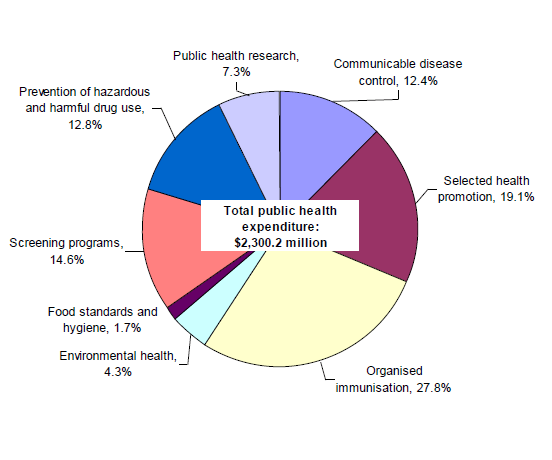Public Health Expenditures and Government Priorities
Increasing the Prevention Budget
Chronic disease is responsible for 83% of all premature deaths in Australia and 66% of the burden of disease, making it our nation’s greatest health challenge.
Conditions such as heart disease, stroke, heart failure, chronic kidney disease, lung disease and type 2 diabetes, are common in Australia. These conditions are largely considered preventable and are placing great pressure on Australia’s healthcare systems as they struggle to deal with the increasing flow of patients. Public health services are vital to the overall health status and wellbeing of the nation. Improving them can result in major economic social benefits as well as minimising future preventable demand on health services over time.
But how much of Australia’s budget is spent on trying to prevent these conditions?
This question is very difficult to answer. The AIHW until 2009, collected public health expenditure with the most recent report dated 2011. In 2012, the public health expenditure series was put on hold, however summary information for public health expenditure is available in the Health expenditure Australia series.
In the report dated 2011, the reported public health expenditure was estimated to be $2 300.2 million in 2008–09. This was an increase of $120.5 million from 2007–08, and represented an increase of 5.5% over the previous year in current price terms. It also translates to around $106 per person.
It is important to understand the definition of public health used in this report, which is:
“Public health activities focus on prevention, promotion and protection rather than on treatment, on populations rather than on individuals, and on the factors and behaviours that cause illness and injury rather than the illness and injury itself.
These activities can take the form of programs, campaigns, or events. They draw on a large variety of methods such as health education, lifestyle advice, infection control, risk factor monitoring, and tax loadings to discourage unhealthy lifestyle choices and changes to the social environment to support healthier behaviour choices. They apply in a multitude of settings (such as schools, homes, workplaces and media outlets), and relate to a broad spectrum of health issues. Public health activities are carried out by the Australian Government, and state, territory and local government agencies, as well as non-government agencies—such as cancer councils and the Heart Foundation—and private health professionals.”
The following diagram details more specific expenditure under public health sub strategies.

Chart 1 – Proportion of total government expenditure on public health activities, by activity 2008-2009
In 2017, Jackson and Shiell released a report: Preventive health: How much does Australia spend and is it enough? that stated Australia spends about $2 billion on prevention each year, or $89 per person. This is equivalent to 1.34% of all health spending and 0.13% of gross domestic product.
The following chart illustrates the changes in spending in public health in Australia compared to similar OECD countries over a decade. Please note that expenditure in NZ was unavailable for 2014.

Chart 2 –Share of health budget spent on prevention 2004 – 2014
Source – OECD (2017). Available here.
When looking at state by state data, WA falls in the middle category for public health expenditure.

Chart 3 – Government expenditure on public health by Australian state and territory in constant prices (base year = 2013/14)
Data source: AIHW Data cubes (2014)
The evidence presented here suggests that a strong case can be made for increasing spending on preventive health and this will remain one of PHAIWA’s priority advocacy targets.
Government Priorities
PHAIWA’s 2017 WA Election Forum
We have identified six priority areas where investments and commitments can be made to ensure the health and well-being of all Australians.
Political Ask One – Public Health at the Local Government Level
Political Ask Two – Public Health for Aboriginal west Australians
Political Ask Three – Improving Prevention at the State Level
Political Ask Four – Low Cost Partial Solution to Reducing Obesity
Political Ask Five – Reducing Fetal Alcohol Spectrum Disorders
Political Ask Six -Low Cost Partial Solution to Supporting Road Crash Survivors
You can view the full document here: PHAIWA 2017 WA Election Platform.
